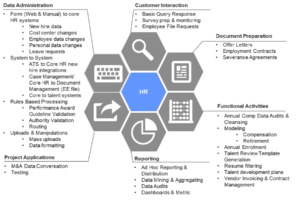 An organisation’s success is a function of its employees. And the advent of Robotic Process Automation or RPA has not changed this basic principle. It is employees and their work that enable companies to offer a unique set of goods or services to their customers. In order to create a great organisation you need great people.
An organisation’s success is a function of its employees. And the advent of Robotic Process Automation or RPA has not changed this basic principle. It is employees and their work that enable companies to offer a unique set of goods or services to their customers. In order to create a great organisation you need great people.
The Challenge for HR in Building a Great Organisation
HR managers have the critical task of hiring, supporting and organising great employees so that they can effectively perform these activities. However and especially in large companies – this involves a staggering amount of data gathering, checking, updating, validating, form filling, and request processing pertaining to talent hire and management. So much so that HR managers find it difficult to focus on anything other than repetitive, administrative tasks. There is thus little or no opportunity for HR departments to add value to the quality and volume of their output. Hence the need for technology to solve these issues.
How can RPA Support HR in Building a Great Organisation

This is where Robotic Process Automation or RPA can be utilised to perform highly repetitive, mundane tasks on an ongoing basis. These include administrative tasks like automating payroll, benefits administration, compliance reporting, etc. And only then will HR be able to focus on its strategic, value-added deliverables such as managing recruiting and hiring quality employees, coordinating employee benefits for talent retention and suggesting employee training and development strategies for talent development.
RPA can drive the following essential HR Processes and Activities
- In pre-boarding and onboarding processes by enabling creation and downloads of pre-signed paperwork and documentation
- Trigger emails on the system for a selected hire for loading onto the relevant system for the onboarding team
- Entering data from forms or other systems to complete the new hire’s past record in a core HR
 system or database
system or database - Entering data to update any additions while tracking master data changes, process requests and generating applicable letters
- Scheduling of a new hire orientation and other training events
- Creation of a compensation processing activity by transferring financial data from spreadsheets or other systems into the core HR system
- Tracking attendance, leave for supporting payroll processing
- Entering one-time payment information from request forms, spreadsheets, or other systems into the core HR system and its tracking
- Separation process activities relating to generating separation letters and calculating or retrieving appropriate exit packages and related documents
- Fulfilling standard report requests including retrieving requests for generating reports and sending to requestors as configured in the system
Getting the Process Flow is Critical
For the success of RPA in the business of Human Resources Management – the creation of the complete end to end process flow must logically emulate the actual real world activity and then integrate it with the process of automation.
Once the design of the process is thought through and created –robust testing is critical to ensure its viability. It is critical not to automate broken processes and to closely monitor the speed and quality of outputs while investing time and effort in exceptions management. Planning for adequate education and change management for adoption of automation by organisations must be carefully created, keeping in mind all possible use case scenarios. Investment in comprehensive stakeholder management and above all ensuring that the process of RPA meets business vision alignment – is critical for success.
Performance improvement solutions which support both the end-user and automation efforts alike will thus ensure an organisation’s realisation of both key performance indicators and larger goals.




